|
Organic farming
Ecological farming allows nature to nurture development
Bread sandwich method can provide vegetables throughout the year
Only market driven strategies can boost organic farming
Easy practice: Earthen pot offers a bounty of benefits for Kanyakumari ryots
Multi-cropping, organic practices overcome soil, water problems
Vegetables can be grown successfully even near the seashore
Panchagavya: low cost organic input for both crops and animals
Kothavasal village shows the way in organic practices
Eco-friendly method of setting up vermicompost unit
Nothing succeeds like `do nothing' technique
Organic sugarcane: profitable through innovative initiative
Natural farming
Switching to forefathers’ methods to cut down expense on inputs
Organic pest-repellent, growth promoters finding acceptance
Ecological farming allows nature to nurture development |
|
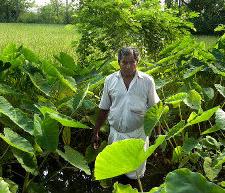
Mr. Sakthi Ganapathi, in his ecological farm at Pudukkottai district, Tamil Nadu.
Agricultural development and research in the country has mainly been focussing on maximising yields, especially during the past 5-6 decades. Though the yields increased substantially, farmers and the environment had to pay a heavy price for this development. With low prices being offered for farm produces and the rising costs of chemical inputs having made agriculture unprofitable, farmers sought new ways to increase their farm incomes in order to survive.
Environment friendly
A conversion to ecological farming requires the farmer to know something about ecological (natural) principles and to be innovative in his ideas and skills.
“All the inputs required are there in the farm itself and the farmer need not go in for anything from outside. In short, ecological farming is organic in practice and ecological in theory,” he said. For example, Sakthi farm covers just about 2.5 acres, located in the out skirts of a village adjacent to Veerapatti –Kerranur road in Pudukkottai district, Tamil Nadu. The farm owned by Mr. Sakthi Ganapathi, is home to several tree varieties. Most of the trees are found growing along the bunds of the paddy fields. Normally farmers cut the trees as they are a hindrance to paddy growth because the shadow cast by the trees hinders the photosynthetic activity of the crops growing near them.
More benefits
“It does, but the ecological benefits are more for my farm than the loss in my paddy crop yield. Several birds have made the trees their home and feed on the insects and pests, which attack my crops. Especially during the night there are some owls which feed on the rats entering my paddy fields. These birds act as effective pest controllers,” explained Mr. Ganapathi. A fish pond has been dug in his field which is covered by water plants. Irrigation water from a well enters the fish pond and then flows into the paddy fields.
No expenditure
Fishes such as Viral (Tamil) are grown in an open well where they lay their eggs and hatch the fries (young fishes). “I do not spend anything for feeding the fishes. The fishes seek their own food such as frogs in the well. The fingerlings are kept in the pond where they hide under water during the day, and swim into the paddy fields during night, feeding on plant eating insects.
In addition the water becomes enriched as manure with their droppings. Full grown fishes are sold,” he said. In addition he also grows ducks which are allowed to roam in the rice fields during the day. The birds, by their constant paddling inside the field, suppress weed growth.
“A combination of two or three functions reduces the cost and labour. I do not choose a separate location for planting my coconut seedlings. I bury the nuts along the irrigation channel and sell the seedlings to the visitors to the farm,” he said.
Adjacent to his farm is a big lake which rarely gets filled. “But when it gets filled three fields of my farm get inundated
Additional benefit
The lake water brings silt into my paddy fields and the matured fishes in the lake find the paddy field is a better place for laying their eggs and breeding young ones. Some of the fishes swim back into the lake when the water drains,” he said.
During summer, when his well water depletes he switches over to crop rotation, by including millet or pulses or green manure crops. Mr. Ganapathy has also found a herbal control for hairy caterpillar menace in groundnut.
Herbal extract
“I spray a fresh extract of four herbs, aloe vera (Sothu kathazai in Tamil), Calotrophis (Yeruku in Tamil), Vitex (Nochi in Tamil) and a hedge plant with white tiny flower and strong smell in the leaves (Peegalathe in Tamil) on the caterpillar (during the early stages) and found that this extract is quite successful in controlling the pest,” he explained.
Contact details: Mr. K. Murali, Indian Organic Agriculturist Movement (IOAM), email: sadhguru@gmail.com, mobile: 94425-31699.
Bread sandwich method can provide vegetables throughout the year |
|
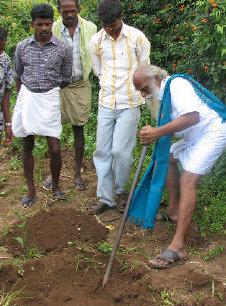
Simple technology: Dr. G. Nammalvar, teaching the farmers the sandwich method.
Vegetables have a short lifespan compared to fruit crops. By making use of modern technologies and inputs, their lifespan can perhaps be extended to say about a year. But if there is a simple method of growing vegetables throughout the year, without any costly gadgets, modern technologies, or costly inputs, it is definitely worth a try for the farmers.
Commonly called the ‘Bread sandwich method,’ once the soil is made ready and the suggested practices followed, one need not work on the soil for the second time. They can go on sowing and reaping, all through the year, according to Dr. G. Nammalvar, organic scientist.
Better yield
But why call it the sandwich method? “We are used to eating sandwich in which vegetable or egg is inserted between two layers of bread. The same method is applied in gardening for a better yield.” “Here, the top soil and sub soil are kept separated by inserting compost between the two layers of soil. Charcoal can also be inserted for better performance,” explained Dr. Nammalvar.
According to him, soil health forms the basis for the production of nutritious food from our garden. “By feeding the micro (soil) organisms and maintaining soil moisture we can harvest maximum solar energy through photosynthesis. For the application of this principle we adopt sandwiching of soil.” The top soil is loose and contains more micro and macro organisms than the sub soil. The roots of plants, whether it is wheat or radish go up to a depth of more than 60 cm into the soil.
Healthy soil
So it is important that the soil is healthy and the micro organisms live till a depth of about 60 centimetres. At the same time farmers must ensure that the top soil is not buried deep. To achieve this result, as a first step, we remove the top soil and keep it separate. Then we split the sub soil. In the third stage, a thick layer of well digested compost is added over the split sub soil. Finally, the top soil is replaced over the compost, said Dr. Nammalvar. This is called as soil sandwiching. Radish and greens can be sown on the edges. Vegetables with wider canopy such as tomato, brinjal, lady’s finger and chilli have to be allowed wider spacing.
Avoid monocropping
“It is wise to avoid mono culture, because plants of the same family compete with each other for light, water and nutrition.” While sowing the seeds, it is advisable for farmers to do relay cropping. Relay cropping means sowing or planting a seed or a plant before the withering of the previous one. At the end of the harvest cut the vegetative parts and put back over the soil. In order to get better quality and more quantity let apply organic inputs.
Suitable combinations
By experience one can understand better combinations. One thumb rule is to see that one legume crop (e.g., cowpea) is sown adjacent to every non-legume (non-pulse) group plants. The bed can be of any length. But it is advisable to keep the width to about 120cm. A bed size of about 1.2mX7.5m will fulfil the vegetables need of a single person (that is 200 gm of vegetables every day). The plants should be watered using sprinkler or rose cane or a hose with shower to create a rain effect. Wastewater used for washing the floors and utensils can also be used. It is better to water the plants during evening,” said Nammalvar.
Minimum income
By adopting this practice a family of five persons can grow vegetables all through the year in 25 cents, or quarter of an acre of land, to ensure a certain minimum income throughout. At present there are about 2,500 farmers all over India who are practising it.
Only market driven strategies can boost organic farming |
|

The villagers of Meekeri in Udhagamandalam
Though organic farming has been proved to be a low investment technology for growing crops, marketing organically produced crops has not been an easy task especially for some farmers. Lack of information on marketing channels and absence of proper governmental guidelines has forced many of them to sell their produce for a throwaway price, an irony when today, organic produce fetches a good price (Rs.3-4 per kg more) than chemical produces. The villagers of Meekeri village, popularly called as organic village, situated about 16 kms from Udhagamandalam, faced a similar problem in marketing their organic produce.
Bio village
The village has been adopted by the Institute of Commercial Horticulture (ICH), Tamil Nadu Agricultural University (TNAU), Udhagamandalam, under the Hill Area Development Programme as a bio-village. The farmers of the village were trained to cultivate their crops under organic practices by ICH. Crucial inputs such as Panchagavya, Dasagavya, Biodynamic compost, vermicompost, Cow pat pit Azospirillum, Phosphobacteria, and bio-control agents such as Trichoderma viride and, Pseudomonas fluorescens for growing the crops were provided by the Institute.
Increase in yield
Mr. N. Sekar, a farmer said, “There is an increase in yield of 5 –10 per cent when compared to chemical farming. But the real problem faced by us was lack of marketing infrastructure and a good price for our produce. Though some NGOs had approached us for buying the produce, their promise of paying us never materialized.
Organic Association
At this point of time the villagers under the guidance of Dr. Selvaraj, approached the Oganic Farmers Association, after reading a series of articles on organic farming and its marketing in the Farmers Note Book column of The Hindu to develop a marketing channel for Meekeri. “Representatives of that Association immediately visited our village and interacted with us. They were satisfied with our produce and made an advance payment for our produce. In fact this is the first time that we have got an advance payment for our organic products,” said Mr. M. Sekar.
Poison free food
Organic Farmers Association comprises nearly 10,000 farmers as its members spanning all over the country and have around 200 outlets under the brand name ‘Poison free Food’ through which the farmers market their produce. The government should take active steps to encourage organic farming in the state. It has been proved that organic farming is a low budget, risk free farming practice which has only positive impact on both the farmers and the environment.
Contact details: Mr. M. Sekar, Meekeri, B. Manihatty P.O., The Nilgiris and Mr. R. Ranganathan at No16-Vanigar street, Thirupporur, Tamil Nadu - 603 110, email: tedetrust@rediffmail.com, phone :044-27478669 and 27446793, mobile: 94433-46369.
Easy practice: Earthen pot offers a bounty of benefits for Kanyakumari ryots |
|

Women farmers being trained to manufacture the mud pot nutrient in Kanyakumari district, Tamil Nadu.
The farmers of Kozhikodupothai in Kanyakumari district, Tamil Nadu, have a traditional knowledge base regarding bio-pest repellent formations and also plant growth promotion formulations. One such traditional formulation called Manpannai sedi thailam in Tamil (Mud pot formulation) combines the effects of both fostering nutritional growth as well as being a pest repellent.
Field experiments
Initially the formulation was experimented with in a small area owned by a rose cultivator Ms. S. Thangam, and was found to completely obviate the need for chemical fertilizers. In addition, Panchagavya was also used for her rose plants. The mud pot formulation on my rose plants had a good effect on the size, yield and growth of flowers. In fact all the flowers had a deep colour and a longer shelf life. The flowers after plucking remained fresh for 2-3 days when kept at room temperature,” said Ms. Thangam.
Natural farming
In fact she was featured in a video at London for the Ashden Award presentations that showcased Vivekananda Kendra-Natural Resources Development Project (VK-Nardep)’s efforts at increasing food production through natural farming practices. Ms. Thangam’s adoption of this innovation encouraged other farmers to try it. Though initially reluctant to stop using chemical fertilizers, they experimented on a small scale first. The economic benefits that each farmer incurred created a cascading effect. For example, two years ago, Ms. Thangam was spending about Rs.3,500 for an acre of rose cultivation. At present her expenditure for an acre has come down to Rs. 1,300.
Decreasing expense
“Using this mud pot formulation and following organic practices has greatly decreased the expenditure I was regularly incurring when using chemical fertilizers,” she said. Mr. Aravindan, social scientist, of the kendra said, an eminent organic farmer and retired agricultural officer, S. Murugan, is responsible for developing this formulation. He had developed a local plant formulation method with a traditional technique practised in Madya Pradesh.
“Once this formulation was tested successfully in Ms. Thangam’s rose field, we decided to give training to more farmers in making this formulation, which has almost been forgotten. According to Mr. Aravindan, about 100 gms of Vitex, Neem and Calotropis leaves each, 50 gm of powdered pulses (any pulse), one litre of curd or thick butter milk, and 1.5 litres of water are the basic items required for making this formulation. The leaves are first ground into a fine paste. The paste is then mixed with the powdered pulses (any pulse). This mixture is then added to one litre of curd. To this is added 1.5 litres of water. The mixture is kept in a mud pot and the mouth covered with a cloth.
The mixture is stirred every day in a clockwise and anticlockwise direction. After 15-20 days the formulation is ready for use. The formulation is diluted in 20 litres of water and sprayed in one acre of crop. The spraying is done on the foliage. The timing is very important for spraying this formulation. The best time is just before dawn and after dusk.
Effective control
The spraying effectively controls several pests and serves as a growth promoter and nutrition provider for the plants. Organic inputs have multiple advantages. Apart from reducing input costs, they also keep the environment safe from toxicity. If one compares a field where chemical fertilizers have been used to grow the crops and a field where organic inputs such as farmyard manure, vermicompost and panchagavya have been used, one can clearly see the presence of earthworms, millipedes and ants is more in an organic field,” Mr. Aravindan explained.
Useful organisms
“Our kendra conducted studies for the presence of earthworms and ants in different fields. We found that chemical inputs greatly disturbed the presence of these useful organisms and in several fields where chemical fertilizers were used these organisms were totally absent. Once some of the farmers started switching over to organic practices, we were able to observe the presence of these organisms again in the soil,” he said.
Contact Details: Mr. S. Aravindan, email. ngc_vknardep@sancharnet.in and vknardep@gmail.com, mobile: 9443748714, phone: 04652 246296 and 04652 -247126.
Multi-cropping, organic practices overcome soil, water problems |
|
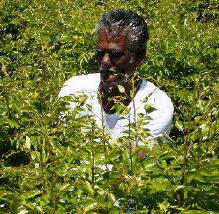
Safe & secure: The farmer, Subbaian in his lush organic farm in Tamil Nadu.
The importance of good soil and clean water for raising any crop can hardly be over emphasised. A soil with low fertility and a contaminated water source can make life very difficult for farmers. “When both soil and water are polluted, we farmers are left with no alternative but to either sell our land or move out and seek some other work to save our family from hunger and starvation,” says Mr. R. Subbaian of Kanakkan thottam, in Coimbatore district, Tamil Nadu.
Sentimental attachment
“Both these options call for tough decisions, as most us have a sentimental attachment towards our lands. To us, the fields are an extension of our family,” he says. His entire 10 acres of land became unfit for cultivation after the water from the chemical waste seepage from the nearby dyeing factories in Coimbatore were let into the Noyyal river, which runs across his village. Like Mr. Subbaian several farmers in and around the village faced this problem and several of them sold their lands and moved into the cities. But with a determination to succeed and a sentimental attachment to his ancestral property, Mr. Subbaian went about hunting for information as to what crops to grow and how to do so with minimal input. After a long and tiring search he was advised to take up multiple cropping and practice organic methods.
According to experts, the multiple cropping system is ideal for farmers as it is an effective method of derisking the income loss for them. In case one crop fails, farmers need not worry but can easily tide over the financial crunch through income from the other crops.
Intercrops
Accordingly, in his 10 acres, Mr. Subbaian planted coconut in three acres, curry leaves in two acres, alfalfa in two acres and tender coconuts in the remaining three acres. He has also planted arecanut as an intercrop in the coconut garden. The crops are grown organically. Though I was into chemical based agriculture several years back, all that was left from it was only debts which accumulated to nearly Rs. 30 lakhs. But after I started practising organic methods, I have realised personally that my expenditure has drastically come down. In addition these organic inputs have helped raise the fertility of my soil. What is the reaction of the farmers who visit his farm? “Many farmers tell me that they have faced losses in their crop yield. Some of them were even toying with the idea of selling their lands to clear their debts. When I seek the reason, they tell me that that they have used more chemical fertilizers in their land to increase the yield but were disappointed when they could not get the desired harvest.”
Personal losses. These farmers did not realise that in addition to facing personal losses, they also had a role in spoiling the environment by dumping chemicals into their land. In contrast organic practices are harmless to the environment. They can be practised by the farmer himself in his fields, require very little investment and are also effective. Even if the farmer uses them in more than the required quantities, they do not affect the crop yield or the environment,” explains Mr. Subbaian. But are organic practices not labour intensive, particularly now, when there is a labour shortage in most villages? “True, but show me a place where is there no labour shortage? Even big companies dispensing good pay packets face this difficulty. It is a global problem. If a farmer decides to go organic he must be prepared to work himself. Even if he has some work men, the farmer should be in the field to personally oversee the operations.”
Beneficial organisms
“To an organic farmer the field is his factory where thousands of beneficial micro organisms and earthworms work all through the day to improve yield and soil fertility. In fact more than the farmer, it is these beneficial organisms which play a vital role in the good growth of the crops,” he explains. In fact much of the crop loss and farmers’ suicides happen only in areas where there is mono-cropping and excess chemical fertilizer usage. Can you ever show me an instance of failure in multi-cropping or in organic farming?” he asks. In about seven years, Mr. Subbaian has been able to pay back his debts after turning organic.
Contact details: Mr. R. Subbaian at 4/5-A, Kanakkan thottam, A.G. Pudur (P.O), Irugur (via), Coimbatore, Tamil Nadu: 641-103, mobile: 0936-3228039, phone:0422-2627072.
Vegetables can be grown successfully even near the seashore |
|
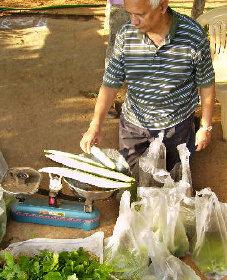
Marketing success: Mr. Venkataraman at his farm with the harvested produce.
A visit to Mr. T.K. Venkataraman’s two ground plot at Akkarai on the East Coast road, just over 15kms from Chennai, will change such an impression. The plot is near the sea (about 250 feet away from the seashore), sandy in nature and suitable for growing only coconut and casuarina trees. With the area developing as IT corridor and land prices zooming, his land was sought for a prime price. I became interested in converting my land into a regular income generation unit rather than selling it after reading a series of articles on success stories of small farmers.
Land made ready
Giving details about how the land was made ready, he said, a concrete wall was first constructed around the land and the soil dug up. A plastic sheet was lined inside the pit and a lorry load of clay was dumped on top of the plastic sheet. Dry paddy straw was placed over the clay and about 150 kg of sawdust was sprinkled over the dried straw. About five lorry loads of red soil and farm yard manure were applied over the sawdust. About 16 furrows were made, and about 5kg of neem cake and 3 kg of vermicompost was sprinkled over them and raked well. Vegetable seeds such as those of brinjal and greens were mixed with some farm yard manure and sprinkled over the furrows and watered regularly.After 2 months, one kg each of Azospirillum, Phosphobacteria, Rhizobium, and 50 kg of vermicompost were mixed together and sprinkled over the germinated seedlings and on the furrows. This practice was followed once every 6 months.
Panchagavya
Every week about 2 litres of cow’s urine diluted in about 6 litres of water was sprayed. In addition Panchagavya spray was also done once a month. For optimum space usage rudimentary pandals (wooden structures) were made between the furrows to grow some vegetables such as double beans. Onions and tomatoes were grown along the borders of the furrows. At present I am able to harvest about 10 kgs of all the vegetables and 30 to 50 bundles of greens a week.
Marketing
The greens are sold for Rs.7 a bundle and the vegetables are sold for Rs. 24 a kg (irrespective of the vegetable grown) to several houses in my neighbourhood. According to Mr. Venkataraman, agriculture is quite a profitable venture if done properly. If I am able to raise vegetables in this sandy soil, definitely experienced farmers can do much better. Farmers must also take the initiative to start their own marketing instead of depending on middlemen. In fact it is the middlemen who take the lion’s share of the profit and the poor farmers have very little to bargain for.
Sucessful marketing
If a farmer is able to sell his produce to about 10 people in his neighbourhood, then he is a success. The government should also consider forming special areas for farming in the periphery of major towns. By doing so farmers will find it easy to take the produce faster to the people in the towns,” he said. The main expense in agriculture is buying chemical pesticides and fertilizers, which take up nearly 80 per cent of the input cost.
Low input cost
“If farmers turn to manufacturing their own organic inputs then the input expenditure can easily be controlled and loss minimized. On an average Mr. Venkataraman earns about Rs. 2,000 as gross income per month from his land. After deducting manual labour and maintenance he is able to retain about Rs. 1,100-1,300 as profit.
Contact details: Mr. T.K. Venkataraman can be reached at No-117-E, 16th cross road, Besant Nagar, Chennai, Tamil Nadu-600090, email: bhavani_venkataraman@yahoo.com, phone: 044-24914299 and mobile: 98407-77459.
Panchagavya: low cost organic input for both crops and animals |
|
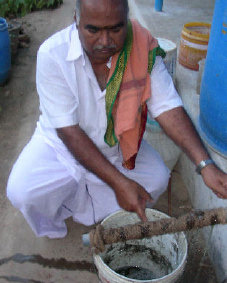
Low cost: Dr. K. Natrajan at his farm in Erode, Tamil Nadu filtering the PG solution for spraying.
Increasing input costs due to inflation, lack of proper marketing facilities, an indifferent government policy and an unpredictable monsoon are some of the identified obstacles in farming operations. “Except lowering the input costs all other issues are not in the hands of the poor farmer. “A low cost, easy to manufacture and proven input, which increases the yield finds popularity immediately among the ryots. And Panchagavya (PG)- organic growth promoter -seems to be the perfect choice for many,” says Dr. Namalwar, organic scientist.
Several hundreds of organic farmers across the country today use PG for their crops.
Organic movement
“While referring to historical dates we use BC or AD. Similarly the history of the organic movement can be divided into two different eras, before PG and after PG,” says Dr. Namalwar.
An organic crop nutrient it can be easily made by farmers themselves and used as a spray for crops and mixed with water while irrigating. “Compared to chemical sprays, in the market which boosts good growth and yield, absence of similar inputs in organic methods was the main reason for the slow spread of the organic movement in the country,” says Dr. Namalwar.
Dr. K. Natrajan, a practising physician and organic farmer from Kodumudi town, Erode, Tamil Nadu discovered PG nearly a decade back. “I never thought that our farmers would use PG in such massive quantities when I devised it,” he says.
Overwhelming response
So overwhelming was the response from farmers across the country, that the Tamil Nadu Agricultural University (TNAU), Coimbatore, did a scientific study on PG and submitted a report stating that PG does increase yield.
In fact the University also started marketing PG to farmers. “Being pocket-friendly accounts for its main popularity,” says Dr. Natrajan. One litre of PG can be manufactured at a cost of Rs. 20 if the inputs have to be bought (if the inputs are available in the farm, then there is no cost).
An acre requires about three litres of PG as spray. If mixed with irrigating water then 20 litres will be sufficient.
Input details
The following inputs are required for its manufacture:
About five kg of fresh cow dung, three litres of cow’s urine, two litres of cow’s milk, curd (made from cow’s milk) and toddy each, 500 gm of cow’s ghee, three litres of sugarcane juice and tender coconut water each and 12 bananas. Cow dung and ghee are mixed well in a plastic drum and covered with a lid. For three days the mixture should be stirred well once during the morning and evening. On the fourth day all the other inputs are added and stirring continued for 15 days.
Shelf life
On the 18th day, PG solution can be used either as a spray (after filtering) or along with irrigation. PG made by this method can be stored for nearly six months.
At regular intervals tender coconut water, sugarcane juice or jaggery diluted in water must be added and stirred well. In the unavailability of sugarcane juice about 500 gm of jaggery diluted in three litres of water can be used.
Alternatives
Similarly in the absence of toddy, two litres of tender coconut water sealed in an airtight plastic bottle for a week (in a week it will transform into toddy) can be used. In the absence of tender coconut water, two litres of black grape juice can be used.
Apart from crops Dr. Natrajan advocates PG as a medicine for cattle and poultry. “Cows yield more milk (nearly 2 litres more) when they are fed with PG.
Similarly the egg laying capacity in poultry chicken also increases. Animals which are fed with PG have been known to be more healthy and resistant to several diseases,” he says.
Kothavasal village shows the way in organic practices |
|
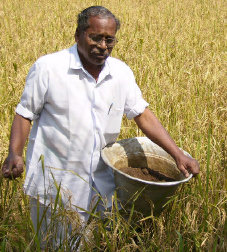
Good example: Mr. M. Manimaran of Kothavasal village in Tiruvarur district
applying algae manure to his paddy crops.
Farmers adopting organic methods and achieving good yields have always been a good model for other ryots.
But for an entire village to adopt organic practices and succeed in getting a bumper yield is by no means a small achievement. The name of the village is Kothavasal, in Nannilam taluka of Tiruvarur district in Tamil Nadu.
Buyers paradise
About 300 acres come under this village limits and farmers grow mainly paddy apart from several vegetables. Unlike in other villages where the farmer has to go to the market to seek marketing channels, during harvesting time buyers throng the village to buy the produce which is organically grown.
How was it possible for an entire village to become organic?
Inspite of several subsidies and financial loans extended by governments under various schemes, the lifestyle of the average farmer seemed to be going down, according to Mr. M. Manimaran, Chairman, Panchayat Union who spoke on behalf of the other farmers in the village.
Low costs
“A farmer with hardly 2-3 acres was finding it difficult to sustain his family with the income from his farm. At this point we were greatly impressed by the trends in organic farming and the low cost of organic cultivation,” he explained.
“We decided to experiment in a few acres and were satisfied with the results. Once a few of us were able to succeed in getting better yields, other farmers slowly started following organic practices and now the entire village has turned organic,” he said.
The input costs for organic farming are comparatively less than those from chemical farming and the produce has ready buyers who pay a decent amount to the farmers. “I have been cultivating mainly paddy in my 30 acres. Previously when I was growing paddy using chemical fertilizers “I harvested about 1,600-1,700 kg of paddy. The expense for cultivating one acre was about Rs, 2,000. But after switching over to organic I now spend only Rs.500 per acre on manures alone,” he explained.
Foliar spray
About 100 kg of farmyard manure (FYM) and 20 kg of sea algae (Kadal paasi in Tamil) alone are applied as manures both in the nursery and in the main field and about 250 ml of liquid algae diluted in 200 litres of water is given as a foliar spray once in 15 days to the crops.
The seedlings were transplanted to the main field from the nursery about 20 days after sowing, and the foliar spray was continued on the 60th and 75th day after transplanting.
The paddy grains harvested under organic methods have been found to have better weight compared with chemical farming, according to Mr. Manimaran. “By the application of algae the weight of paddy grains has increased. Earlier, when I grew my paddy crops with chemical pesticides, one bag of harvested paddy weighed about 56 kg.
Paddy weight
“Presently under organic cultivation the weight of the bag has gone up to 60-62 kg (one bag is 60 kg). Because of the weight increase we are able to get Rs.1,200 more per acre,” he noted.
Another surprising feature is that the paddy fields in which algae have been applied are not infested with rats which pose a difficult problem to paddy farmers.
Application of chemical manures increases the sweetness of the paddy crop and so rat infestations are more. On the other hand in organic farming the sweet content is lower and rat infestation is not so much, he explained.
Policy consideration
The entire village has presented a memorandum to the Government to formulate a policy on organic farming for farmers.
The villagers wanted the government to extend credit facilities to organic cultivators as at present banking institutions extend financial assistance only to farmers using chemical pesticides.
Contact details: Mr. M. Manimaran, Panchayat Union Chairman at Kothavasal village, Nannilam taluka, Tiruvarur district, Tamil Nadu, phone: 04336-238347, mobile: 9486044229.
Eco-friendly method of setting up vermicompost unit |
|
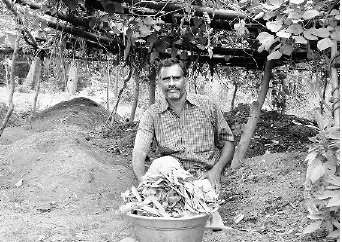
Ingenious technology: Mr. D. Bharani, a farmer in Mayildathurai
with a bumper harvest, in front of his vermicompost unit.
Vermicompost is the basic ingredient for successful organic farming. More than 85 per cent of organic crop cultivation depends on it. Usually farmers across the country build a roof either with thatched straw or asbestos sheets as a cover for their vermicompost manufacturing unit.
The bottom of the unit will either have sand or plain cement or sometimes toughened red soil.
A progressive organic farmer, Mr. D. Bharani of Mayiladuthurai taluka in Tamil Nadu’s Nagapattinam district, has used local tree trunks for the four poles supporting his rudimentary compost unit.
Climbing tendrils
“The tree trunks absorb the moisture from the compost unit and grow as individual trees,” he says. For the roof, he has used the climbing tendrils of vegetable plants growing near the compost unit.
The plants grow well, absorbing the required moisture from the unit and their leaves provide shade to the manufacturing unit. “In addition to making the compost which I sell at Rs 5-8 per kg, I am also able to sell vegetables such as bhendi, brinjal, snake gourd and bitter gourd grown on the roof of the compost shed,” he says.
“Farmers, instead of spending money on constructing thatched sheds and asbestos, can follow simple methods like this. By doing so, they can get double income from the compost unit and the vegetables.”
He is also cultivating rasthali banana variety in about four acres. “Commercially, rasthali has a good demand in the market compared to other varieties and if consumers know that it is grown organically, then the farmer need not search for buyers. It will be vice-versa,” he says.
Sturdy against winds
But why did he choose rasthali variety when there are so many other varieties? “Rasthali variety does not grow quite high and is often sturdy against strong winds.”
Strong winds often uproot banana trees and farmers have to tie each tree to a wooden pole to prevent the tree from falling or getting uprooted. “Secondly organic practices are found ideal for my banana orchard as banana is often found susceptible to wilt disease which is a major and fatal infestation.
“Chemical control methods have not been found successful in controlling this infestation, compared to organic methods,” he explained.
“I had purchased the suckers from known sources and from healthy trees. The suckers, before planting were dipped in a solution of 10 per cent Panchagavya and 50 gm of pseudomonas for 3-5 minutes.
For an acre, about 780-800 pits of 8x8 (row to row and plant to plant) were dug and the suckers were planted in them. About 3 kg of farm yard manure (FYM) was also applied in each pit.
Heat generation.
The FYM was applied a little distance away from the pit, because if it were applied directly into the pit or near the suckers it would spoil the plant growth due to heat generation. Panchangavya spray was done once every month till the crop was about 5 months old.
He was able to harvest his first yield in about 14 months after planting and this variety can be maintained for two years.
“One bunch was sold for Rs. 120-130 and I was able to get a net income of Rs. 80,000.
“The expenditure for maintaining one tree comes to about Rs. 35 and after deducting the expenses for all my plants I am still able to get a net profit of Rs. 50,000.” he said.
Contact details: Mr. D. Bharani can be contacted at Kothangudi village, Komal post, Mayiladuthurai taluka, Nagapattinam district, Tamil Nadu: 609-805, phone: 04364-228711 and 04364-237415 and mobile: 9486278569.
Nothing succeeds like `do nothing' technique |
|
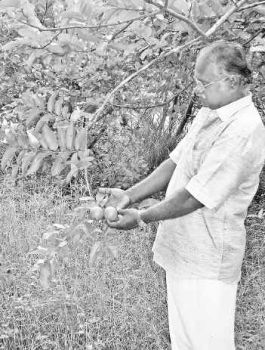
Mr. Sethuraman, an organic farmer inspecting the fruits in
his orchard which are ready for plucking.
Spiralling input prices, unsure market and mounting debts have forced the farmers to think of viable alternatives and organic farming has emerged as the best solution.
Basic inputs
Compared to chemical farming, organic farming is within the control of the farmer as all the basic inputs such as cattle and dung are available in the farm itself, according to Mr. M. Sethuraman, a progressive organic farmer in Kidathalaimedu village in Mayiladuthurai taluka of Nagapattinam district in Tamil Nadu.
Farmers must be free to cultivate and market their produce without any hurdles. "This is possible only in organic cultivation and cannot be expected in chemical cultivation as several factors such as the price of the produce and fertilizer cost are decided by the government and not by the farmer," he noted.
Planting details
Mr. Sethuraman is presently growing about four guava varieties in his one-acre field. The seedlings were planted at a spacing of 15x15x15 feet distance in triangular planting technique. The fruits are harvested twice a year. The first harvest is done usually during March-April and the second during August-September.
From an acre, about 12-15 tonnes of fruits are harvested in a year. Giving details on his guava cultivation, Mr. Sethuraman said, "The method I am practising is called `do nothing' technique. "I do not follow the usual recommendations which chemical farmers do for raising their crops such as spraying pesticides, split fertilizer application and foliar spray." "The field was ploughed well by applying 2-3 tonnes of vermicompost and the seedlings were planted. In addition I had released a lot of earthworms into the soil."
Rain harvesters
Earthworms, apart from enriching the soil, also serve as effective rain harvesters. The soil becomes porous because of their constant burrowing and water is able to seep freely into the soil and increase the water table. Many small farmers are apprehensive about switching to organic farming, according to him. "They feel it is a risky experiment and can suit only big farmers. But they fail to understand that they can get the same or a better harvest without spending much on chemical pesticides and fertilizers," he said.
All they have to do is prepare organic pesticides, fertilizers and growth promoters from plants and other material available in their own farm. They need not depend on chemical fertilizers and pesticides and get caught in debts, he elaborated.
He has been using an organic growth promoter called Amirthakaraisal as a spray for his guava crops. It can be prepared by mixing about 5-10 kg of fresh cow dung, 8-10 litres of cows' urine, 1 kg of jaggery and 90-100 litres of water in a cement tank and helps in getting good yield.
Reducing costs
According to him, farmers cannot do much to change government policy that determines output prices, trade tariffs, social security and subsidies which are beyond their control, but they can try to reduce cultivation costs by practising organic cultivation. For controlling pest attacks and infestations in his guava orchard, Mr. Sethuraman has been using bio pest repellent prepared from leaves of nochi, pongamia and calotropis.
Rural employement
These plants are the potential source of pesticides, because animals do not eat them as they have an inherent toxicity in them," he explained.
He employs about five people during the harvesting season to pluck the fruits. Manual harvesting offers a good scope for rural employment for people in the villages, according to him. "I face no problem in marketing the fruits. Being organic the demand is good and I have buyers at my doorstep to take the produce. By adopting the do nothing approach in a year I am able to get a net income of Rs. 60,000 to Rs. 65,000, he said.
Contact details: Mr. M. Sethuraman at Kidathalaimedu, Kali post, Mayiladuthurai 609 811, Tamil Nadu, Phone: 04364-236467.
Organic sugarcane: profitable through innovative initiative |
|

Mr. R. Ranganathan, President of Organic Farmers Association, inspecting his crop.
CHEMICAL PESTICIDES and fertilizers have always been considered `manna' from heaven for Indian ryots, especially after the second green revolution. Farmers believe that by applying potash and urea to the soil their crop can be made to yield more.
But a vast majority of them have failed to realise that excessive application of these chemicals over the years has poisoned the land, water and the environment.
Health hazard
More than 75 per cent of the food crops grown today have toxic residues of chemicals used for growing them andthey are hazardous for human health, according to Mr. R. Ranganathan, President of Organic Farmers Association in Chennai.
Mr. Ranganathan, an organic farmer himself, is growing sugarcane in his 8-acre farm in Mayiladuthurai taluka, Nagapattinam ditsrict of Tamil Nadu.
Use of organic methods for crop cultivation is no rocket science, according to him. "These traditional methods were used for decades, but forgotten along the way and now have been rediscovered as safe and affordable alternatives," he explains.
Expected yield
He is expecting to harvest about 40-50 tonnes of sugarcane per acre, compared with farmers who use chemicals in the area who harvest about 30-40 tonnes.
His farm is a model for other aspirants and he is also teaching other farmers the benefits of use of various plant leaves such as neem, castor, custard apple, cow's urine, dung and curd to make insect repellents and vermiwash.
Horizontal planting
Detailing his cultivation technique, Mr. Ranganathan said, "The field was ploughed well into furrows by applying about 1,000 tonnes of vermicompost.
The sugarcane setts were planted on the furrows horizontally at a spacing of about 4x4 feet between them."
In addition to vermicompost, several earthworms were also released into the field. Irrigation was done twice every week initially after planting and later continued once every 15 days. About 20 litres of diluted Panchangavya was also sprayed twice over the crop.
The first spray was done 15 days after planting the setts in the main field and the second in the third month, according to him. Dethrashing of the dried leaves and removal of weeds, which are usual practices in crop cultivation, were not done.
No weeding
"The dried leaves and weeds were also allowed to grow, as they are also a part of the ecosystem," he explained.
Once a month the dried leaves were pulled manually and left to rot in the field, as they are a good source of manure to the plants. The duration of the crop is about one year and Mr. Ranganathan is expecting four ratoons from his crop. Like other sugarcane growers, he is not selling his produce to the local co-operative sugar mills. "The recent price hike announced by the government is an eye wash, he claims. A farmer gets about Rs.1,200 per tonne of sugarcane, but he is not paid for the by-products such as ethanol or molasses," he said.
He, along with other organic sugarcane farmers in the area, are planning to manufacture moulded jaggery (called achu vellam in Tamil) from the harvested sugarcane.
Organic jaggery
Moulded organic jaggery gets a good price especially during the festival season and also creates employment opportunities for the several persons who produce it, according to him.
He plans to sell the moulded jaggery through the several organic product outlets established by his association in the country.
Marketing outlets
The organic farmers association has about 10,000 farmers as its members all over the country.
It has around 200 outlets all over the country under the brand name `Poison-free-food' through which the farmers market their produce.
Contact details : Mr. R. Ranganathan at No16-Vanigar street, Thirupporur, Tamil Nadu-603 110, email: tedetrust@rediffmail.com, phone :044-27446369, mobile: 94433-46369.
Mr. Sunderaraman, is functioning an organization called ‘TamilNadu Farmers’ Technology Institute at Kambupallam near Sathyamangalam, Erode. This organization is devoted to natural farming and it has spread to various parts of TamilNadu. It provides training on natural farming to farmers from TamilNadu, Kerala, and other neighboring centers.
Some 20 years back his land has been the experimental plot for test verification of most pesticides and chemicals. The land had become futile over years. In 1991, he took a decision (i.e.,) not to use inorganic, in his field from then on, he has developed various technologies to get yields similar to the yields obtained from inorganic. One such technology is the RK. Bacteria – a natural growth promoter.
Preparation of RK Bacteria :
In a 50lt plastic can, add 5kg fresh cow dung, ¾ kg powdery jaggery, 25g Kadukkai powder (Terminda chebula nuts) and mix well. Adhimathuram (Glycyrrhiza glabra) 2 ½ g should be boiled with ½ liters water and this liquid should mixed with the content can, Fill the can with water and keep it cloud. Two days later the can gets filled with methane gas. Slightly loosen the crop to avoid bursting of can. The RK bacteria is ready after 10 days. The contents are transferred to another can. 200lt of RK bacteria solution is applied for 1 acre along with irrigation water.
Mix 1lt of RK solution in 1o liters of water and spray over the crops to increase the leaf size up to 20 %. This increases photosynthesis thereby the yield tends to improve. This spray acts as pest repellant too.
Mr. Sundararaman explains another growth hormone. It is named as ‘Themor’. This is prepared using 5litre of tender coconut water. These are poured in a can. Take coconut grating of 10 coconut and 10 kg of rotten fruits in a plastic bag or gunny bag and it is put into the solution in the can after tying the bag. On the 7th day a foul smell comes out which is an indication that Themor is ready.
Mix ½ liters Themor with 1 litre RK bacteria and 10lt of water and spray. This produces more beneficial microorganisms. It has the capacity to control fungal diseases. This is on par with Cytocin and Biocin growth hormones. This increases flower and fruit yield.
Arappu mor Suspenson – Growth hormone :
Take arappu (Albezia amara) leaves (1litre cup full) and powder it but not fully mix it with 1 litre tender coconut water, 5 litres of sour buttermilk. Arappu can be replaced by 50g Shikakai soapnut (i.e.,) Sapindus mukorosse) 10kg of rotten fruits should taken in netted plastic bags or gunny bags, tied and immersed in a can containing the above said mixture. The suspension is ready in 7 days.It can be used in the proportion as indicated in Themor.
Vermicompost Preparation:
This was explained by Uppupallam Ravi, member of the Institute. Coconut husk should be spread and over this RK bacteria should be poured. It should be done in furrows of height 9inch and width 2 feet. Add earthworms to it and cover it with gunny bags. Once the compost is ready, the earthworms move down and the manure left on top can be used. These are the basics of natural farming.
Contact :
TamilNadu Farmers Technology Institute
Sathyamangalam, Erode.
Telephone : 04295 – 225047
Mobile : 98427 24778.
Switching to forefathers’ methods to cut down expense on inputs |
|
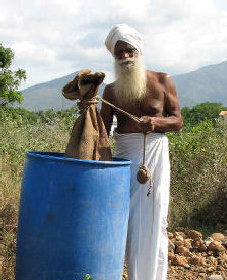
Namalwar demonstrating the manufacture of herbal tea for crops
“There is a popular adage in English, “give a man a fish he lives for a day, teach him to fish he lives for a lifetime,” This is exactly what our farmers need today.“Instead of buying external inputs such as seeds, chemical fertilizers and pesticides, they should learn to make and use their own bio pest repellents, and plant growth promoters,” says Dr. G. Namalwar, organic scientist from Tamil Nadu.
If one studies the agricultural scenario of the past 40 years, one observes that hundreds of cultivable areas are turning into residential plots.
Why is this happening in a country with more than 1,500 years of agricultural heritage?
Wrong focus
The answer is simple. The Green Revolution focused more on increased inputs and yields and totally ignored the local and traditional knowledge systems of the farmers.
As a result, in 40 years we lost our native seed varieties, our lands became barren, native birds and insects which helped the crops grow well vanished, water tables started depleting, cross breeding of hybrid cows made several native breeds extinct and there has been more migration towards cities due to unemployment in rural areas.
Not remunerative
Today there is a general view that farming is not remunerative and that a farmer cannot cultivate unless he obtains loans.“It is true that farming is not lucrative as long as a farmer uses external inputs for growing his crops. On the other hand if he switches to sustainable agriculture as was done by his forefathers then he can definitely cut down a major expense on his input,” he emphasises.
Friendly farming
Hundreds of farmers have realised this truth and have switched over to more environmental friendly farming systems and are reaping good results.
Farmers just need to look around their own fields or village for making any bio inputs.
All the necessary inputs required for their farm are there and there is no need for them to go to the towns and buy, according to Dr. Namalwar. He says that, for example, for making a plant growth stimulant labelled as herbal tea, take an iron, plastic or cement tank and fill it with water (3/4 full).
Take 5 kg of cow dung and any medicinal plant leaves (such as neem, nochi, custard apple leaves), one-fourth kg jaggery and one big stone or brick.
Place all the above mentioned items inside a jute sack, tie the mouth of the sack tightly with a rope and immerse it inside the water.
Leave the other end of the rope free. Shake the sack, holding the free end of the rope two times everyday in such a way that the contents inside the sack mix well with the water (similar to the tea bags immersed in milk).
One week time
In one week the ‘herbal tea’ for the crop is ready for use. It can be either poured directly near the root zone of the crops or sprayed. For one litre dilute in nine litres of water and use.
Amudha Karaisal
Similarly take 1 kg of fresh cow dung, urine and Ipomoea Cornea (Tamil name Neiveli Kattamanakku) leaves each and 25 gm of jaggery. Mix all these well in 10 litres of water and stir well (3 times a day). In 24 hours the solution (Amudha Karaisal, AK) is ready. For use, dilute one litre of AK in 10 litres of water and spray or mix with irrigating water.
But how far are these local systems beneficial in the long run?“These traditional systems have existed for hundreds of years and only for the past 4-5 decades have they disappeared.
Realised importance
But today our farmers have realised the importance of going back to these systems as they are pocket friendly and effective,” he opines.
Though we have policies which speak out in support of the farmer, sadly they are only on paper and not put in action. “A farmer must realize that he alone is responsible and answerable for his yield. These systems may look insignificant but their results are proven and have been found effective by a number of farmers,” he says.
contact: Dr. G. Namalwar through email: sadhguru@gmail.com and mobile: 94425-31699.
Organic pest-repellent, growth promoters finding acceptance |
|
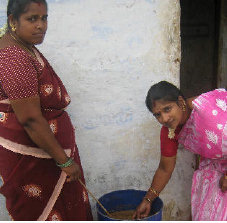
Women in Thandalam village, Tamil Nadu involved in the manufacture of panchagavya.
AGRICULTURE IS undergoing a rapid change.“Today, farmers and their problems get more prominence thanks to media exposure.“Though modern intensive agriculture using pesticides and fertilisers resulted in self sufficiency in food production, it made farming an expensive activity.“The quality of the produce in terms of its safety for consumption has also become a question,” says Mrs. Radha Parthasarathy, Managing Trustee, Thandalam Yogakshema trust, Chennai.
However, in order to make both ends meet, farmers now are left with no other option than to practice chemical agriculture.
Eco-friendly practices
With practically little help on the appropriate way of modern eco-friendly agricultural practices, many small and marginal farmers sell their lands and migrate.
A development of serious concern, which if not addressed properly and at the right time, may lead to food crises and a set back in the rural ecosystem, thereby strangulating our fragile village economy, according to Mrs. Radha.
Marketing
The trust, at present, is encouraging farmers in sustainable agricultural practices and also helping them to market their produce at Thandalam village on the Arakonam-Kuminipettai road in Vellore district.
The village (about 3 kms from Arakonam town), situated in a remote area,is connected to the nearest town by just one private operated mini bus.
Need guidance
“Though at first our work involved some renovation work in the village, I realized during my several interactions with the villagers there, that it is the farmers who need proper guidance (in terms of sustainability and marketability of the produce).“Unless these two are not practised, the future of rural economy is definitely dark for our country,” explains Mrs. Radha.
Mr. Harish Krishnamoorthy, consultant horticulturist says: “Initially, convincing the villagers proved to be a daunting task. “We wanted to initiate these proven organic systems of cultivation and for that we had to go their way and slowly started emphasizing the need for organic methods among them.
Positive results
“Though many pooh-poohed our ideas, the positive results such as good yield from a neighbouring field made them curious and interested.“Once they expressed their willingness to practise organic methods it was quite easy for us to train them.”
Generally, today in many places the general situation is that, oncesome infestation occurs, farmers take the infested part of the crop to the nearby pesticide shop and buy the spray.
In many cases several of these sprays are spurious and often pose a threat to both the farmer and his crop in terms of cost and quality of the produce.
“As part of our activities, whenever we interact with the farmers, we always stress the need for natural farming and at the same time are careful not to compel any of them to adopt it for our sake. This is because, we believe that the farmers must get convinced first and then start on it,” says Mr. Harish.
Offer training
The trust trains some farmers to prepare their own pest repellents and plant growth promoters such as Panchagavya which control a number of infestations according to the farmers.
Giving details on how the pest repellants are made Mr. Harish says:“Leaves of custard apple and nochi, neem leaves, garlic, green chilli, ginger are all ground into a fine paste and boiled in cow’s urine.
“It is then filtered and sprayed. It controls some common infestations such as, shoot and fruit borer in brinjal and tomato crops. In addition, they are trained in manufacturing vermicompost, which they sell.”
The trust also encourages the women by forming a self-help group which makes a variety of food items and spices.
For more information readers can contact Thandalam yogakshema trust, Regd office: No 14, Satyanarayana Avenue,Off Boat Club Road, Raja Annamalai Puram, Chennai- 600 028, phone: 044- 24340448, email: harish_matangi@yahoo.com and thandalam@gmail.com , mobile- 98412-75883.
|
|














